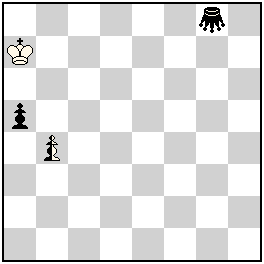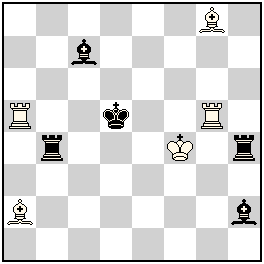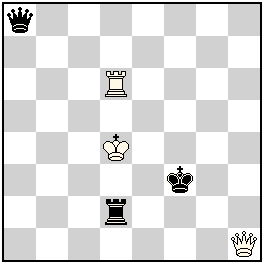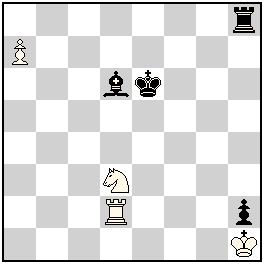|
|
Original Problems, Julia’s Fairies – 2013 (III): September- December →Previous ; →Next ; →List 2013(III) Please send your original fairy problems to: julia@juliasfairies.com |
Happy New Year to all of you from Peter Harris!
Enjoy 5 problems dedicated to: commentator Seetharaman, Tadashi Wakashima, Manfred Rittirsch, Vlaicu Crisan, and to your editor. Thank you, Peter! (JV)
Definitions:
Maximummer: Black must play the geometrically longest move or may choose from among longest moves of equal length, distances being measured from the center of each square. Diagonal and oblique distances are measured from the orthogonal coordinates by using Pythagora’s theorem (take the square root of the sum of the squares of the orthogonal distances). All other orthodox chess rules apply.
Super-Circe: When captured, a piece is reborn on any free field on the chess board without causing self-check or selfmate. Possible is also removal of captured piece from the board. The Pawns (white, black, neutrals, half- neutrals) can be reborn on the first or eight row also. When reborn on the first row (for Black) or on the eight row (for White) the promotion is obligatory. When reborn on the first row (for White) or on the eight row (for Black) the Pawns are immovable.
Andernach Chess: A piece (excluding King) changes its color after any capturing move. Rooks on a1, h1, a8 and h8 can be used for castling, provided the usual other rules for that move are satisfied.
Isardam: Any move, including capture of the King, is Isardam illegal if a Madrasi-type paralysis would result from it.
Madrasi: Units, other than Kings, are paralysed when they attack each other. Paralysed units cannot move, capture or give check, their only power being that of causing paralysis.
PWC: When a capture is made, the captured unit (except a King) is replaced on the square the capturing unit just leaves. A Pawn is immovable on its 1st rank.
Anti-Supercirce: A capturing piece [including a King] can [and must] be reborn on any vacant square without causing self-check. Pawns can be reborn on their eighth or first rank; promotion is obligatory; Pawns reborn on their first rank are dead.
Chameleon: On completing a move, a Chameleon (from classical standard type) changes into another piece, in the sequence Q-S-B-R-Q… Promotion may be to a Chameleon at any stage in the cycle if any Chameleon piece is presented on the board.
|
No.466 Peter Harris
South Africa
original – 30.12.2013
Dedicated to commentator Seetharaman.
 hs=3 b) neutral Ka7 (1+2+1n)
Maximummer Super-Circe (no black King) Solutions: (click to show/hide)
|
No.467 Peter Harris
South Africa
original – 30.12.2013
Dedicated to Tadashi Wakashima.
 hs#3 3 solutions (5+5)
Andernach Chess Isardam Solutions: (click to show/hide)
|
|
No.468 Peter Harris
South Africa
original – 30.12.2013
Dedicated to Manfred Rittirsch.
 hs#2,5 Duplex (3+3)
Super-Circe Isardam Solutions: (click to show/hide)
|
No.469 Peter Harris
South Africa
original – 30.12.2013
Dedicated to Vlaicu Crisan.
 hs#3 2 solutions (4+4)
PWC Maximummer Isardam Solutions: (click to show/hide)
|
|
No.470 Peter Harris
South Africa
original – 30.12.2013
Dedicated to Julia V.
 h=2 b) + Circe (2+4)
Chameleon a2 c2 a1 b1 Anti-Supercirce Note: In this problem Circe has priority over AntiSupercirce. The capturing piece cannot relocate to the rebirth square of the captured piece.
Solutions: (click to show/hide)
|
|


 No.466, 467, 468, 469, 470
No.466, 467, 468, 469, 470
Thank you very much for dedicating a wonderful, harmonious problem with perfect economy to me! I am very pleased!
Happy new year to you, Julia and all the readers!
Thanks Peter for dedicating this beautiful problem to me. It takes time to work out why the first solution does not work with a neutral King .. Very nice ! Wish you, Julia and all the other experts a very happy new year !
It’s also interesting to work out why the second solution does not work with a white king! The subtle twinning is really the star here.
467: It looks like PH just put four pairs of like pieces on the board, in the familiar configuration where no K is in check because the capture of a K would result in an Andernach colour change that produces an illegal Isardam observation – but somehow, three exact and interesting solutions appear!
I and II have a W3 check in the opposite configuration: a K stands between two like pieces of different colour, so there is a check (because of Andernach) and the K cannot leave the line (because of Isardam). II and III have a B3 mate in the same configuration, produced by a capture with colour change – a paradoxical effect: Black mates just by making one of his pieces white! I has a B3 mate by withdrawing a piece from a thematic line, and III has a W3 check by the same mechanism. So the play is unified in three pairs (would someone like to read a cycle into this?)
There are a couple of weak spots: repetition of Rb4-d4, and the fact that the white bishops are passive in I and II (but they do stop a cook with bKb7 and Rg5-g8-b8). But all in all – a wonderful result of just “putting pieces on the board in an interesting configuration”!